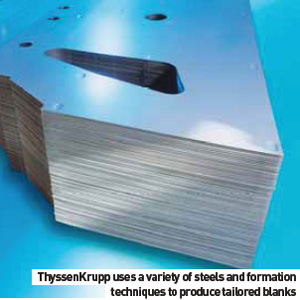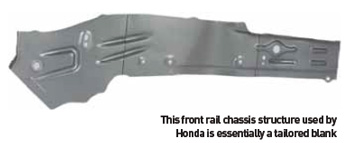
New laser joining techniques, steel grades, and how laser ablation can improve welded joins
The concept of the tailored blank is generally acknowledged to have its origins back in the 1980s in the German automotive sector. Its central idea is extremely simple: a tailored blank consists of two or more pieces of metal that are joined together before being pressed into a final part in a way that enables that part to have customised properties – for instance greater thickness over a particular area.
By any measure it is an idea that has proven extremely attractive to carmakers. The use of tailored blanks is now common throughout the global automotive manufacturing industry. Quite apart from the intrinsic advantages the technique can offer, a primary attraction is that the basic concept is available in the public domain, instead of being the intellectual property of an individual or company.
No hard figures exist as to the quantitative use of tailored blanks, but Daniel Wenk, Head of Sales Systems for Soutec Soudronic, based in Neftenbach, Switzerland, and a major supplier of laser equipment used to make tailored blanks is well-placed to offer an estimate.
According to Wenk’s calculations, the average use of tailored blanks in new cars in 2008 was approximately six per vehicle in Europe, while North American and Asian carmakers used four per unit. On that basis, he estimates a global usage total of about 340 million tailored blanks in 2008. From this, Wenk projects a steady increase in the use of tailored blanks, with global numbers reaching around 475 million units by 2012.
Given that Soutec claims to provide the equipment with which around 70% of the world’s automotive tailored blanks are made, Wenk might be forgiven for contemplating that prospect with a degree of satisfaction.
Soutec itself was not involved in the market from the outset, but in the two decades that it has featured, the developments in its own technologies have been in line with industry trends. According to Dr Johann Härtl, for instance, manager of the company’s technical centre, Soutec started out in 1990 with a machine that was based on the ‘resistance’ welding technique.
A little over a year later, the company had moved on to production of the laser welding machines that now dominate the market. At that time, the machines were strictly linear in operation, meaning they could do no more than straight line welds. Indeed, it was another decade until, in 2003, the company introduced its first non-linear machines capable of producing curved weld seams. Now the market is dominated by laser machines. Dr Härtl says that as far as the company is aware, there are only three of its resistance machines still in operation. In contrast, he reports that there are over one hundred and twenty of its laser machines currently in use at customer sites worldwide.
 For the most part, those customers are steel producers acting as Tier One or Tier Two suppliers to OEMs.
For the most part, those customers are steel producers acting as Tier One or Tier Two suppliers to OEMs.
Carmakers in their own right are a rarity in the company’s customer base, though still not unknown. Dr Härtl reports that there is a good deal of background contact between Soutec and carmakers, the latter providing direct feedback on laser performance, as well as indications as to the way the technology should develop.
According to Dr Härtl, there have been some noteworthy trends in the use of laser welding. Initially, CO2 lasers were the norm, but that began to change after 2004, as the emphasis switched to solid state devices. But even within that switch over, there has been a another distinct strand of development, with YAG lasers giving way to the latest disc or fibre machines. Dr Härtl explains that the driving force behind that most recent evolution has been a demand for increased electrical-to-optical efficiency, rather than an improvement in beam quality. YAG lasers, he says, convert electrical energy into laser light with an efficiency of only around three to five per cent, while the latest disc or fibre machines can do so with around 35% efficiency.
Interestingly, Dr Härtl reports one particular geographical bias in the use of the technology. In Asian countries, India and China specifically, supplies of steel coil are limited to rolls just 1.5 metres in width, which means that two strips must be welded together to achieve anything wider, for example, to form the roof of a truck cab.
In broad terms, there are essentially just two basic types of tailor-welded blanks, with the metal pieces either joined at their sides (butt-welded), to make larger blanks of uniform thickness, or overlapped pieces can be welded to make ‘patchwork’ blanks, these with areas of varying thicknesses. Add to these the many variations in steel grades, join configurations and net shapes and the application possibilities become virtually limitless.
UK steel supplier Corus manufactures laser-welded tailored blanks for the automotive industry at its site in Wednesfield, UK. According to Senior Consultant Andy Clough, based at the company’s Automotive Support Unit, located on the campus of Warwick University, Corus has been in the business for over a decade. Clough points out that as someone who previously worked in the composites industry, he is surprised at how long it took the automotive sector to start exploiting the full potential of tailored blanks.
But Clough confirms that Europe now leads the world in its development and use of the technique. He also identifies two nascent trends in the area that might become more pronounced over the next few years, the greater use of tubular components made through the tailored blanking technique and the advent of physical rolling as a tailoring methodology. The latter, he says, is ‘just beginning to creep in’.
But whatever the technique, Clough indicates that light weighting of vehicles to help diminish CO2 emissions is likely to be an increasingly important driver in the take-up of tailored blanking. He points to the possible introduction of even more stringent legislation in the middle of the coming decade as a crucial factor, explaining that a reduction of vehicle weight by approximately 10% can return 6% cuts in CO2 emissions.
Meanwhile, Corus’s most recent tailored blank contract has been to provide three key parts for BMW’s Mini Clubman: the outer left- and right-hand bodysides and the Club door inners.
In the US, the take-up and development of the concept is now the subject of a specific, industry-wide initiative, involving suppliers both of tailored blanks and of the production equipment. The Tailored Steel Product Alliance (TSPA) currently has eleven member organisations. But, as Peter Mould, Program Manager relates, the organisation started out as an initiative of the American Iron and Steel Institute (AISI) based in Southfield, Michigan, and is in fact, one of several automotive-related collaborative ventures that the AISI has launched.
According to the TSPA, the potential benefits of tailored blanks encompass both vehicle performance and manufacturing efficiency. These include:
- elimination of parts and/or reinforcements
- reduced numbers of parts
- reduced tooling and fixturing
- lower inventory
- savings in floorspacereduced stamping requirements
- overall mass reduction
- enhanced crash performance
- reduced NVH
- improved dimensional control
- improved corrosion resistance
Mould says the TSPA has already completed a number of projects aimed at publicising the benefits of tailored blanks, crucially providing engineers with appropriate cost justification tools. The importance of this initiative – and this is a point commonly made by all proponents of the technology – is that taken in isolation, the cost of tailored steel components could well appear to be greater than that of a traditional, monolithic counterpart. But once process costs and material wastage have been factored in, the equation usually points the other way.
In fact, a major activity for the TSPA is updating its cost justification tool. Mould explains that the existing tool was originally drawn up by a working group of the Auto Steel Partnership, a much older AISI initiative dating back to the 1980s and involving a mix of major US carmakers and steel suppliers. With that, he does admit that the tool, essentially a calculation methodology devised with the assistance of the Massachusetts Institute of Technology, is perhaps overly complex. “We want to make it easier and less intimidating,” he explains.
The TSPA is now looking to revise a manual on the technology of tailor-welded blanks that was similarly inherited from work completed by the Auto Steel Partnership. Mould indicates that the original work focussed primarily on manufacturing techniques and that the intention now is to produce a version with much greater emphasis on applications.
Keeping process costs in mind, the TSPA is keen to stress that it is the complete process and not just isolated fabrication that is the key consideration. Sample case studies take three theoretical examples – a door inner, a front rail and a body side inner – and compare the respective total costs for a laser-welded blank and a ‘baseline’ conventional counterpart.
The front rail case study perfectly illustrates the need to take into account all associated costs when doing a comparison calculation. Material, blanking and welding costs for the tailored blank are noticeably greater than that of the baseline, $52.88 compared to $42.87, but add tooling, labour and ancillary equipment to the total and the results are dramatically different: $105.43 for the tailor-welded blank, compared to $127 for the baseline.
Klaus Loeffler, International Sales Manager for Trumpf Laser Systems, is reticent about using the term ‘tailored blanks’, explaining that he regards the term as increasingly inadequate given the growing number and type of laser applications required to produce customised fabrications ready for further processing. He identifies the growth of tubular products, in addition to those made from sheet metal, as making the word ‘blanks’ insufficient, preferring the term ‘tailored materials’.
Loeffler confirms that Trumpf itself acts as a supplier of complete laser systems for producing such materials, as well as a source of equipment for both system builders and automotive industry customers. Nevertheless, he says that lasers for producing tailored materials account for a maximum of 5% of Trumpf’s total global laser sales for automotive applications. The market, he observes, is one that is currently marked by considerable over-capacity.
Vendors like Trumpf need to offer additional services above hardware in order to remain competitive. Loeffler indicates that one way Trumpf does this is by acting as a consultancy, outlining the best use of lasers in the production of tailored materials. Customers using lasers as replacements for older welding methods may fail to appreciate the implications for the final products.
For instance, Loeffler points out that the use of a laser obviates the need for flanges in fabrications, something that can make a direct contribution to material savings, further reducing part weight and cost.
A lot of the joins which lasers now make were, he says, not originally designed with that fabrication technique in mind. “There needs to be proper education beforehand to get the best out of the technology.”
An important new application area for lasers in the production of tailored blanks is opening up not in welding, but in ablation – the removal of surface coatings that might otherwise adversely affect the quality of weld joins.
 According to Markus Rütering, Product Manager with Rofin-Sinar, based in Hamburg, Germany, the 1990s and the early part of this decade saw Rofin enjoying a thriving trade selling lasers for the production of tailored blanks. It did so, however, one level removed from the end users, its customers being the systems integrators selling complete installations. But Rütering points out that even before last autumn’s downturn, he had noticed a fall in the sale of blank-welding lasers. Like a lot of businesses, he puts this down to a correction of market over-capacity.
According to Markus Rütering, Product Manager with Rofin-Sinar, based in Hamburg, Germany, the 1990s and the early part of this decade saw Rofin enjoying a thriving trade selling lasers for the production of tailored blanks. It did so, however, one level removed from the end users, its customers being the systems integrators selling complete installations. But Rütering points out that even before last autumn’s downturn, he had noticed a fall in the sale of blank-welding lasers. Like a lot of businesses, he puts this down to a correction of market over-capacity.
Rütering makes that point with one caveat; most existing blank pressing operations have been working with lowerto medium-strength steels – from 300-800 megapascals (MPa) in strength. But with the introduction of new, higher strength materials (up to 1,500Mpa), requiring hot rather than cold-forming operations, the protective zinc coating could not survive the forming process.
A new aluminium-silicon coating was developed to resist forming temperatures as high as 900C, but they in turn suffer from a potential drawback. As Rütering explains, such temperatures during pressing cause the coating to degrade, forming ‘intermetallic faces’ at the joining points. These weaken the welds that are integral to the performance of the blank as a whole.
The solution is to carry out a controlled laser burn of the coating at the points where welding will take place. For the task, Rofin has introduced a family of laser devices – its ‘q-switched’ machines - that Rütering describes as “rodbase, fibre-delivered YAG machines that produce beams of one micron wavelength.” The real innovation in the devices, though, is the switching technology that ‘pulses’ the beam in a manner analogous to a drill’s hammer action.
The devices were integral to an announcement made in 2007 by ThyssenKrupp Steel, when it unveiled what was claimed to be the first ever hot-stamped tailored blanks in a production car. The blanks in question were being used by Audi in construction of the A4 and A5 models, both introduced that year. The locations for the blanks were the B-pillars, rear side members and tunnel reinforcements.
The components used manganese-boron steels to facilitate thinner walls, reducing body weight without detracting from passenger safety. According to ThyssenKrupp, the parts are first heated to temperatures between 880 and 9500C before being formed, followed by a very rapid cooling; more than 30 Kelvins per second.
The combined process produces an extremely hard microstructure in the material, the parts virtually free of residual stresses and therefore, extremely accurate. In this case, Audi uses steel with an aluminum-silicon coating.
In fact, Audi used tailored blanks consisting of both manganese-boron steel and a conventional microalloyed deep drawing steel. In the case of the B-pillar, the part has to be able to yield in the lower third to effectively absorb crash energy. In contrast, the upper two thirds must be hard enough to protect the upper body and head of the driver or front-seat passenger in a side impact.
Made of microalloyed deep drawing steel, the B-pillar has a thickness of 1.5mm at all points and a strength of approximately 500MPa in the bottom third. ThyssenKrupp says that if the whole of the B-pillar were to be made by cold stamping an advanced high-strength steel, the sheet thickness (and thus part weight) would be much greater.
Audi also uses a manganese-boron and microalloyed steel combination for the rear side members, while the tailored blanks for the tunnel reinforcement consist of individual manganese-boron steel sheets of different thicknesses.
Rofin-Sinar worked with ThyssenKrupp for about a year to develop the required capability. In this case, the laser removes a 1.5mm-wide strip of coating on either side of the weld gap to facilitate a butt-weld of the required integrity.
Luxembourg-based ArcelorMittal is a major supplier of steel suitable for hot-stamping, including tailored blanks. The company’s Usibor 1500 P grade steel has an aluminium-silicon coating that suits laser ablation pre-treatment, in turn enabling it to combine the weld integrity associated with cold-stamping and the resilience provided by forming through hot-stamping.
According to Philippe Antoine, Co-ordinator for Steel Solutions, the company has been involved in producing steels for tailored blanks since the mid-1990s. “That was the real start-up, from the global point of view,” he confirms.
Since then, Antoine continues, demand for tailored blanks and the steels to produce them has followed what he terms “the evolution of general applications”. He says this has meant catering to two specific categories of customer demand – those for “lightweighting” and enhanced “crash behaviour”. This is what has prompted the development by ArcelorMittal of the ultra high-strength steels typified by the Usibor range.
Markus Rütering says that Rofin-Sinar intends to move the relevant laser technology forward later this year, citing a weakness in the technology in regards to the unequal process speeds at which current-generation lasers can carry out welding and coating removal operations. Rather surprisingly, perhaps, the former can be accomplished more quickly than the latter. Rütering says that that while welding can be carried out at speed of 10-12m/min, laser ablation rates are in the range 6-10m/min. But 15-18 June this year will see the LASER – World of Photonics 2009 exhibition taking place in Munich. “Just wait to see what we will be releasing,” says Rütering.
What other advances the technology will undergo in the near future remains to be seen. The two major innovations of recent years have been the introduction of non-linear welding techniques and the extension of the approach to extremely hard metals capable of undergoing hot-stamping.
Johann Härtl at Soutec suggests that the next major step forward is likely to be the introduction of “invisible seam” techniques, probably involving some sort of remelting process, which will enable tailored blanks to be used in exterior bodywork. Indeed, he confirms, research to that effect is already underway.




































